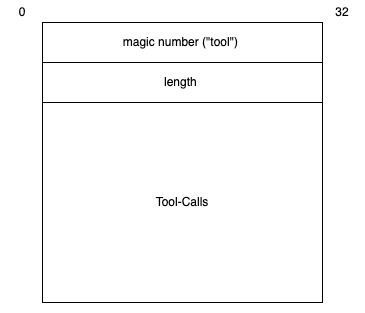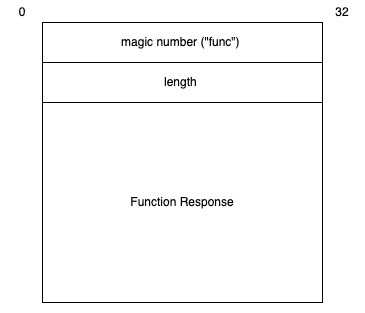在实时对话式 AI场景下,你可能需要 Function calling 功能将大模型与外部工具和 API 相连,助力大模型向实际产业落地迈进。在使用火山方舟大模型时你可以使用此功能。关于 Function calling 的详细介绍,请参看 Function calling 功能介绍。
你可通过以下步骤在该场景下使用 Function calling 功能:
步骤 1: 配置 Function calling 函数工具。
步骤 2: 接收工具调用信息。
步骤 3: 将工具调用信息传回 RTC 服务端。
步骤 4: 收到 Function calling 音频回复。
其中步骤 2 和步骤 3 支持多轮 function call 调用。当 Function Calling 的流程结束后,用户会收到房间内智能体的音频回复消息。
步骤 1:配置 Function calling 函数工具
你可参看 startVoiceChat 接口LLMConfig.Tools 字段进行 Function calling 函数工具配置。
你可以参考以下示例代码进行请求:
POST https://rtc.volcengineapi.com?Action=StartVoiceChat&Version=2024-06-01 { "AppId": "661e****543cf", "RoomId": "Room1", "UserId": "User1", "Config": { "BotName": "audiobot_user1_1611736812853", "ASRConfig": { "AppId": "93****21", "Cluster": "volcengine_streaming_common" }, "TTSConfig": { "AppId": "94****11", "Cluster": "volcano_tts", "VoiceType": "BV002_streaming" }, "LLMConfig": { "Mode": "ArkV3", "EndPointId": "epid****212", "MaxTokens": 1024, "Temperature": 0, "TopP": 0.3, "SystemMessages": [ "你是小宁,性格幽默又善解人意。你在表达时需简明扼要,有自己的观点。" ], "UserMessages": [ "user:\"你是谁\"", "assistant:\"我是问答助手\"", "user:\"你能干什么\"", "assistant:\"我能回答问题\"" ], "HistoryLength": 3, "WelcomeSpeech": "Hello", "Tools": [ { "Type": "function", "function": { "name": "get_current_weather", "description": "获取给定地点的天气", "parameters": { "type": "object", "properties": { "location": { "type": "string", "description": "地理位置,比如北京市" }, "unit": { "type": "string", "description": "", "enum": [ "摄氏度", "华氏度" ] } }, "required": [ "location" ] } } } ] } } }
步骤 2:接收工具调用信息指令
当用户的问题触发 Function calling 时,你需要接受接收本次函数工具调用的信息指令,你可以使用以下方式接收:
- 配置StartVoiceChat.Config.FunctionCallingConfig后使用通过配置的 URL 接收本次函数工具调用的信息指令。
- 使用onRoomBinaryMessageReceived客户端回调接收本次函数工具调用的信息指令。
配置 StartVoiceChat.Config.FunctionCallingConfig 接收
你的业务服务器将通过来自 RTC 服务器的 HTTP/HTTPS POST 请求收到消息,示例如下:
{"message":"xxxx","binary":false,"signature":"0016mW5n58="}
以上示例所含字段解释如下:
| 字段名 | 含义 | 类型 | 合法性 |
|---|---|---|---|
message | 消息内容 | string | 消息格式为二进制,格式参看消息格式。 |
binary | 是否二进制 | bool | 非空 |
signature | StartVoiceChat.Config.FunctionCallingConfig 中设置的 signature。 | string | 非空 |
消息指令的格式为二进制,格式如下:

| 参数名 | 类型 | 描述 |
|---|---|---|
| magic number | binary | 消息格式,固定为 tool。 |
| length | binary | 信息指令长度,单位为 bytes。存放方式为大端序。 |
| Tool_Calls | binary | 信息指令详细信息。格式参看Tool_Calls。 |
Tool_Calls
| 参数名 | 类型 | 是否必填 | 描述 |
|---|---|---|---|
| subscriber_user_id | String | 否 | 用户 UserId。 |
| tool_calls | Array of tool_call | 是 | 工具调用信息列表。 |
| id | String | 是 | 本次工具调用的唯一标识 ID。 |
| type | String | 是 | 工具类型。 |
tool_call
| 参数名 | 类型 | 是否必填 | 描述 |
|---|---|---|---|
| function | String | 是 | 方法参数。 |
| name | String | 是 | 方法名称。 |
使用 onRoomBinaryMessageReceived 客户端回调接收
消息指令的格式为二进制,格式如下:
| 参数名 | 类型 | 描述 |
|---|---|---|
| magic number | binary | 消息格式,固定为 tool。 |
| length | binary | 信息指令长度,单位为 bytes。存放方式为大端序。 |
| Tool_Calls | binary | 信息指令详细信息。格式参看Tool_Calls。 |
Tool_Calls
| 参数名 | 类型 | 是否必填 | 描述 |
|---|---|---|---|
| subscriber_user_id | String | 否 | 用户 UserId。 |
| tool_calls | Array of tool_call | 是 | 工具调用信息列表。 |
| id | String | 是 | 本次工具调用的唯一标识 ID。 |
| type | String | 是 | 工具类型。 |
tool_call
| 参数名 | 类型 | 是否必填 | 描述 |
|---|---|---|---|
| function | String | 是 | 方法参数。 |
| name | String | 是 | 方法名称。 |
消息指令解析示例
你可参看以下示例代码对消息指令进行解析。
//定义结构体 struct function { std::string arguments; std::string name; }; struct ToolCall { std::string id; std::string type; function func; }; struct ToolCallsMsgData { std::string subscribe_user_id; std::vector<ToolCall> tool_calls }; //回调事件 void onRoomBinaryMessageReceived(const char* uid, int size, const uint8_t* message) { std::string tool_calls; bool ret = Unpack(message, size, tool_calls); if(ret) { ParseData(tool_calls); } } //拆包校验 bool Unpack(const uint8_t *message, int size, std::string& tool_calls_msg) { int kToolCallsHeaderSize = 8; if(size < kToolCallsHeaderSize) { return false; } // magic number "tool" if(static_cast<uint32_t>((static_cast<uint32_t>(message[0]) << 24) | (static_cast<uint32_t>(message[1]) << 16) | (static_cast<uint32_t>(message[2]) << 8) | static_cast<uint32_t>(message[3])) != 0x746F6F6CU) { return false; } uint32_t length = static_cast<uint32_t>((static_cast<uint32_t>(message[4]) << 24) | (static_cast<uint32_t>(message[5]) << 16) | (static_cast<uint32_t>(message[6]) << 8) | static_cast<uint32_t>(message[7])); if(size - kToolCallsHeaderSize != length) { return false; } if(length) { tool_calls_msg.assign((char*)message + kToolCallsHeaderSize, length); } else { tool_calls_msg = ""; } return true; } //解析 void ParseData(const std::string& msg) { // 解析 JSON 字符串 nlohmann::json json_data = nlohmann::json::parse(msg); ToolCallsMsgData toolcalls_data; // 存储解析后的数据 toolcalls_data.subscribe_user_id = json_data["subscribe_user_id"]; // 遍历 JSON 数据并填充结构体 for (const auto& item : json_data["tool_calls"]) { ToolCall tool_call; tool_call.id = item["id"]; tool_call.type = item["type"]; auto fun_json = item["function"]; tool_call.func.arguments = fun_json["arguments"]; tool_call.func.name = fun_json["name"]; toolcalls_data.push_back(tool_call); } }
步骤 3:将工具调用信息指令传回 RTC 服务端
在使用 onRoomBinaryMessageReceived 获得消息指令后,你需要将该消息指令传给 RTC 服务端。你可以使用以下方式传回:
- 调用
UpdateVoiceChat服务端接口传回; - 调用
SendUserBinaryMessage客户端接口传回。
调用 UpdateVoiceChat 服务端接口传回
你可参看 UpdateVoiceChat 接口使用 Command 和 Message字段将信息传回。
可参考以下示例:
POST https://rtc.volcengineapi.com?Action=UpdateVoiceChat&Version=2024-06-01 { "AppId": "661e****543cf", "RoomId": "Room1", "UserId": "User1", "Command": "function", "Message":"{\"ToolCallID\":\"call_cx\",\"Content\":\"上海天气是台风\"}" }
调用 SendUserBinaryMessage 客户端接口传回
你可调用SendUserBinaryMessage接口将工具调用指令信息按照二进制格式传回。
二进制消息格式
二进制消息格式如下:
| 参数名 | 类型 | 描述 |
|---|---|---|
| magic number | binary | 消息格式,固定为 func。 |
| length | binary | 信息指令长度,单位为 bytes。存放方式为大端序。 |
| Function Response | binary | 信息指令详细信息。 |
传回指令信息示例
你可参看以下示例代码传回工具调用指令信息。
import VERTC from '@volcengine/rtc'; /** * @brief 将字符串包装成 TLV */ function stringToTLV(inputString: string) { const type = 'func'; const typeBuffer = new Uint8Array(4); for (let i = 0; i < type.length; i++) { typeBuffer[i] = type.charCodeAt(i); } const lengthBuffer = new Uint32Array(1); const valueBuffer = new TextEncoder().encode(inputString); lengthBuffer[0] = valueBuffer.length; const tlvBuffer = new Uint8Array(typeBuffer.length + 4 + valueBuffer.length); tlvBuffer.set(typeBuffer, 0); tlvBuffer[4] = (lengthBuffer[0] >> 24) & 0xff; tlvBuffer[5] = (lengthBuffer[0] >> 16) & 0xff; tlvBuffer[6] = (lengthBuffer[0] >> 8) & 0xff; tlvBuffer[7] = lengthBuffer[0] & 0xff; tlvBuffer.set(valueBuffer, 8); return tlvBuffer.buffer; }; /** * @brief TLV 数据格式转换成字符串 * @note TLV 数据格式 * | magic number | length(big-endian) | value | * @param {ArrayBufferLike} tlvBuffer * @returns */ function tlv2String(tlvBuffer: ArrayBufferLike) { const typeBuffer = new Uint8Array(tlvBuffer, 0, 4); const lengthBuffer = new Uint8Array(tlvBuffer, 4, 4); const valueBuffer = new Uint8Array(tlvBuffer, 8); let type = ''; for (let i = 0; i < typeBuffer.length; i++) { type += String.fromCharCode(typeBuffer[i]); } const length = (lengthBuffer[0] << 24) | (lengthBuffer[1] << 16) | (lengthBuffer[2] << 8) | lengthBuffer[3]; const value = new TextDecoder().decode(valueBuffer.subarray(0, length)); return { type, value }; }; /** * @brief 通过 onRoomBinaryMessageReceived 接收 toolcall * 通过 sendUserBinaryMessage 发送 response */ function handleRoomBinaryMessageReceived( event: { userId: string; message: ArrayBuffer; }, ) { const { message } = event; const { type, value } = tlv2String(message); const data = JSON.parse(value); const { tool_calls } = data || {}; // 处理逻辑 console.log(type); if (tool_calls?.length) { const name: string = tool_calls?.[0]?.function?.name; const map: Record<string, string> = { getcurrentweather: '今天下雪, 最低气温零下10度', musicplayer: '查询到李四的歌曲, 名称是千里之内', sendmessage: '发送成功', }; this.engine.sendUserBinaryMessage( 'Your AI Bot Name', stringToTLV( JSON.stringify({ ToolCallID: tool_calls?.[0]?.id, Content: map[name.toLocaleLowerCase().replaceAll('_', '')], }) ) ); } }; /** * @brief 监听房间内二进制消息 */ this.engine.on(VERTC.events.onRoomBinaryMessageReceived, handleRoomBinaryMessageReceived);
步骤 4:获取 Function calling 最终答复
当 Function Calling 的流程结束后,用户会收到房间内智能体的音频回复消息。